
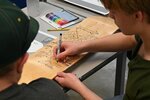

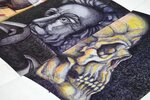

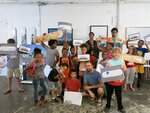

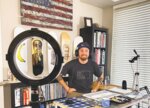
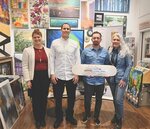
Mark Rivard is not your typical educator. He never went to college. He was not that good a student in high school. And he calls himself “uneducated.”
But he has found a way to connect with young people through art and skateboards, and he is disrupting the education system just the way he disrupted the art world.
Rivard, a Longfellow resident, began his art career drawing on skateboards with Sharpie markers in the early 2000s. That led to an international endorsement campaign with Sharpie in 2011. A year later, he launched Do Rad Things, an active lifestyle brand, educational platform, and way of life. He has been inspiring others and doing rad things ever since.
“The journey,” Rivard explained during a “Let’s Connect” event in February, “goes from initially just drawing on skateboards and doing art shows and learning about the art world to eventually getting into some galleries and things like that. And then eventually endorsement deals with companies like Sharpie. And then ultimately starting a skateboard company in 2007. I actually started the company Rivard Art LLC and then inadvertently landed myself in schools.
“And now I’m running a kind of full-time art education business.”
Rivard Art LLC is the parent company of Rivard Art Education, an arts educational program that offers experiential learning opportunities for young people around the world. That business has become Rivard’s passion.
It’s funny the way life works. After Sharpie helped put Rivard on the map as an artist, he got invited to speak at schools. He never much cared for school when he was growing up, but when he visited elementary schools and high schools, locally in Minneapolis at first and then around the world, Rivard realized that talking to students in schools was really interesting.
“I just saw myself in a lot of these kids,” said Rivard. “I wasn’t the best student. School didn’t come naturally to me. And seeing myself and a lot of those students was pretty inspiring for me. So I just started to really kind of gravitate that route. It felt good.”
Rivard found that art was a great way to break the ice with youth: “I think of my art as storytelling more than anything. To sit down and draw a skateboard, these are all a story. All of my paintings, pictures, whatever the case may be, I tell kids all the time this is storytelling, and you all have a story to tell. It kind of breaks down the idea that art is just a strictly sort of solo thing that you do and only certain kids do. Because when you get a lot of these kids to start telling stories, it gets pretty interesting.”
Education, unlike the solitary nature of studio art, is a collaborative process. Rivard recognizes that an artist can spend a lot of time in their own head and their own thoughts. While he values “that selfish time in the studio,” he appreciates the unselfishness of teaching.
“I felt that power right away when I started visiting schools. I got the education bug, started writing curriculum, and realizing there were so many components to a skateboard, to a pop culture item, to an athletic item, to an art canvas. It was just a million directions I could take it, and it really blended well with curriculum. Before I knew it, I was almost full-time working education.”
The biggest challenge for educating youth is money and getting the budgets to fund schools and fund creative programming.
“Every single kid can benefit from these programs, from the art kid to the skate kid to the athletic kid. There is no shortage of interest. There is a shortage of budget,” Rivard pointed out. “Money is the biggest thing. It’s funding these schools. Making sure schools have the budgets to create engaging and intriguing, I call it experiential learning programming. When you can do something that a kid automatically understands, whether they skateboard or not is pretty irrelevant, they know this item as a pop culture icon. So whether you are a skateboarder or not, you put that on your arm, you’re fairly empowered. And that’s experiential learning. You’re learning something more than just the arts.”
The hard part is getting kids to engage. Once you find a way to do that, the possibilities are limitless.
DO RAD THINGS
“I often tell a lot of educators as I am bringing my programs around, that art is sort of the entry point,” Rivard underscored. “This is a conversation to figure things. This is a conversation to entrepreneurship. This is a conversation to so many self-promoting and marketing and empowering things that happen through simply drawing on a skateboard. But the biggest challenges are not that it’s not too much of a challenge to create the curriculum. It’s a challenge to find the budget for it. We just don’t fund the schools well enough.”
Rivard recommends society gets creative to fund schools and creative programming. Like the time he took students on a field trip to a screen print shop and printed T-shirts that said “Do Rad Things,” then had kids sell them after coining the phrase during a learning session.
“I just said, at the end of the day, you just got to do rad things. And the phrase came out, and it became the classroom model. Just do rad things,” Rivard recalled. “It doesn’t necessarily matter where it’s gonna lead. We’ll figure that out when we get there. As long as it’s awesome, whatever we’re doing right now, as long as we’re doing rad things, we’re gonna find a good route to wherever we need to go.
“So I bought all the shirts, I paid for the screen printing, and then I said it’s your job to go and sell these at school. I need to make my money back, and you guys can keep the profit. I ended up paying the kids the profits, and they went out and sold all the shirts. That becomes an entrepreneurship lesson. It becomes a lot of things. And so do rad things was universal, and it felt right. It just felt very authentic to what I do, who I am, and how I grew up.”
Kids are still wearing those “Do Rad Things” shirts around town. But even more than that, they are living the mantra.
That is education, believes Rivard. And that is how to reach and teach more kids today.
“I’m big on, same way I wish schools were investing more into our students, I put my money where my mouth is,” Rivard summed up. “Those kids, my own personal dollars went to go make this happen. I’m big on investing in the kids not only in an emotional support way but in a very real-life financial way. There’s so much more to an art class. One thing you’re not going to learn in art is marketing, finance, these types of things. If you can find a way that you hook them with skateboards and with art, then the lesson really becomes all of the other business side of it.
“All of those little aspects that come in, and that creates the real value in the programming. Investment in the students, not just talking about it, but being about it. You know, truly spend the money and invest in these kids.”
Count on Rivard to keep inspiring students and the world to do rad things.
Comments
No comments on this item Please log in to comment by clicking here